碳基超级电容器研究进展
2015-12-12黄士飞史姗姗赵玉峰
佟 琦,黄士飞,史姗姗,赵玉峰,∗
(1.燕山大学环境与化学工程学院,河北秦皇岛066004;2.燕山大学河北省应用化学重点实验室,河北秦皇岛066004)
碳基超级电容器研究进展
佟 琦1,2,黄士飞1,2,史姗姗1,2,赵玉峰1,2,∗
(1.燕山大学环境与化学工程学院,河北秦皇岛066004;2.燕山大学河北省应用化学重点实验室,河北秦皇岛066004)
作为一种绿色环保的新型储能装置,超级电容器近年来发展迅速,电极材料是决定超级电容器性能与制造成本的最主要因素。碳材料因种类多样、价格廉价并具有较高的比表面积、较高的导电率和非常好的化学稳定性而被作为一种重要的电极材料广泛应用于储能元件中,主要包括活性碳、碳微球、碳纳米管、石墨烯等。碳基超级电容器是以碳材料作为主要电极材料的一类电容器。本文详细介绍了不同碳基电极材料的研究发展状况,以及碳基超级电容器的研究与应用进展。
超级电容器;碳材料;研究进展
0 引言
随着全球气候变暖,能源与环境问题的日益突出,人类越来越倾向于对清洁能源和可再生资源的研究与利用。超级电容器(supercapacitors)又称作电化学电容器(electrochemical capacitors),作为一种介于常规电容器与二次电池之间的新型高效储能元件得到了人们的关注与研究。相比电池而言,超级电容器具有充放电速度快(小于3 min)、使用寿命长(可达100 000次)、功率密度高(大于1 kW/kg)、绿色环保等优点[1⁃6]。在诸多储能装置中,超级电容器在比能量(高于传统电容器)和比功率(高于二次电池)等性能方面具有明显优势[7],如图1所示。若将其与电池结合则可提供较高的能量和较大的功率,满足电动汽车启动、加速、爬坡、制动之大功率需求。未来超级电容器将会被广泛应用于电动汽车、航天、能量存储,以及军事和无线通讯等重大领域[8⁃9]。其中,碳基超级电容器以碳材料作为主要电极材料,是目前最为广泛使用的一类超级电容器。
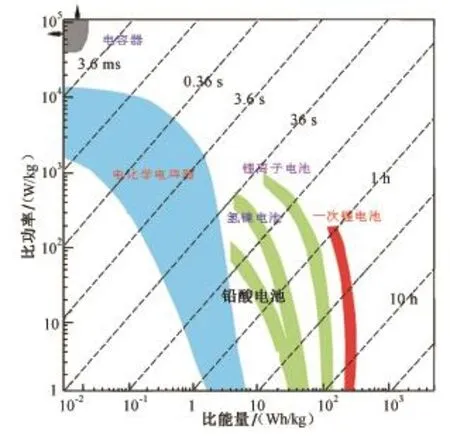
图1 各种储能器件比能量与比功率的关系图(Ragone图)Fig.1 Relationship of energy density and power density of various energy storage devices(Ragone plot)
为了满足实际应用与需求,目前高能量密度和高功率密度的超级电容器成为了研究的热点。然而,对于如何设计和构筑基于碳材料的兼具高功率密度和高能量密度超级电容器,依然是一个富有挑战性的核心问题[10⁃11]。本文首先介绍了碳基超级电容器的储能机理,详细阐述了碳基超级电容器领域电极活性材料的研究进展,并介绍了相关电极材料在不同电解质体系中的应用,同时对碳基超级电容器的发展进行了展望。
1 碳基超级电容器储能机理
超级电容器按照其储能原理可分为两类:双电层电容器和赝电容器。赝电容也称为法拉第准电容,是在电极表面或体相中的二维或准二维空间上,电活性物质进行欠电位沉积,发生高度可逆的化学吸附/脱附或氧化/还原反应,产生和电极充电电位有关的电容[12]。双电层电容器的基本原理是利用电极和电解质之间形成的界面双电层来存储能量的一种电子元件[13]。碳材料大都具有比较大的比表面积,碳基超级电容器大多为双电层电容,图2说明了几种碳材料包括多孔碳、碳微球、碳纳米管、石墨烯等在双电层电容器中的储能机理。
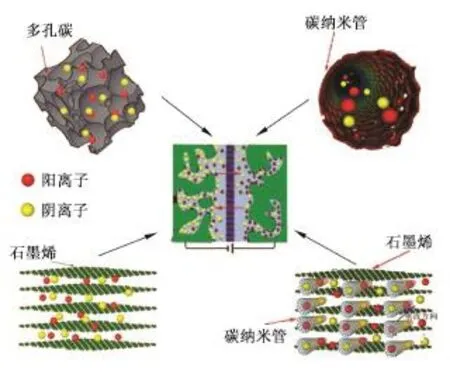
图2 不同碳材料的储能机理图Fig.2 Energy storage mechanism of different carbon materials
超级电容器的比电容主要取决于碳材料的比表面积、孔隙大小、孔径分布和表面基团等因素的[14⁃15]。理论上来讲比表面积越大,碳材料所具有的比容量也应该越大。但事实上材料的质量比容量与其比表面积并不成线性关系。研究表明,当活性物质的比表面积大于1 200 m2/g后,材料的比电容不再随之继续增加[16]。较大的比表面积可以为离子的吸附/脱附提供更多的活性位点,而大于2 nm(水系)或5 nm(非水系)的介孔(2~50 nm)的存在则有利于电化学双电层的形成,同时也为离子的传输提供了具有较小阻力的通道。由于部分离子去溶剂化发生在微孔(<2 nm)中,所以微孔的存在可以提高材料的比电容(水系0.7 nm、有机体系0.8 nm时最佳)[17]。
此外,碳材料表面官能团的存在则具有改善电极材料与电解液之间的润湿性能和提供赝电容作用[17⁃22]。在碳材料中引入杂原子如B、N、O、S、P、F等是提高比电容的一种有效途径,杂原子的掺入不仅可以增加碳原子的活性,同时可以贡献赝电容和改善碳电极材料的亲水性[23⁃27]。杂原子的掺入一方面可以引入亲水官能团;另一方面可以改变碳原子的电荷分布,与杂原子相邻的碳原子电荷密度会随着掺杂得到增强,从而提高碳材料对电解质离子的吸附性能,同时也直接影响着双电层电容的大小。目前,杂原子增强电容的因素主要包括[28]:①杂原子增加了材料的亲水性位点,电极材料的润湿性能有所提高(尤其是对于水系电解液)[29⁃31];②杂原子一般为富电子体,其引入大大增加了材料整体的电子密度,使材料的导电性有了一定提高,从而降低了电容器的等效串联电阻[32⁃33];③电子密度的增加出现了空间层电容[34⁃35];④杂原子使碳材料变为供电子体,在法拉第传荷过程中产生了赝电容[33⁃36]。但是,杂原子的掺入并非都是积极的。研究表明,杂原子或官能团过多时,等效内阻会增大[37⁃39],漏电电流也会明显增大[40],从而会极大地影响电容器的使用寿命[41]。因此,只有适量的掺入杂原子才会提高碳材料的电化学性能[42⁃45]。由于对于杂原子掺杂提高电化学性能的机理还处于探究阶段,目前研究者们对于其了解比较有限。
2 碳基电极材料
作为主要的电极活性材料,碳材料包括多孔碳[46⁃48]、碳 微 球[49⁃57]、碳 纳 米 管[58⁃59]、石 墨 烯等[60⁃64],它们大都具有形貌结构丰富可调、比表面积较大,以及化学稳定性好等优点,广泛应用于各类超级电容器,如图3所示。
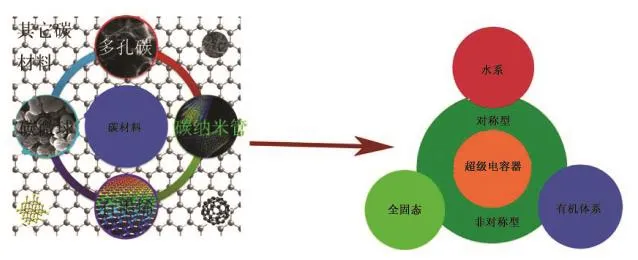
图3 不同碳材料及其在超级电容器领域中的应用Fig.3 Application of various carbon materials in supercapacitors
2.1 多孔碳
多孔碳(PC)一般具有较大的比表面积、良好的导电性和非常好的化学稳定性,是最早应用于超级电容器中也是目前使用最为广泛的一类电极材料。多孔碳大多为无定形碳,也存在排列有序的晶体碳,一般是通过对含碳前驱体进行高温碳化活化处理而得到。多孔碳前驱体来源广泛、廉价易得,木材、动物骨骼、花粉、果壳、秸秆、煤炭、有机聚合物等都可以用来制备多孔碳。其活化方法主要分为两种:①物理活化(水蒸气和二氧化碳活化);②化学活化(KOH、NaOH、ZnCl2、H3PO4、H3BO3等)[65]。因其所选碳源和制备工艺的不同,最终所得到的碳材料电化学性能差异显著(见表1)。其中以生物质为碳源,通过一系列活化剂后处理制备的活性碳或者多孔碳因其超大的比表面积、丰富的杂原子以及低廉的生产成本而受到更多青睐。
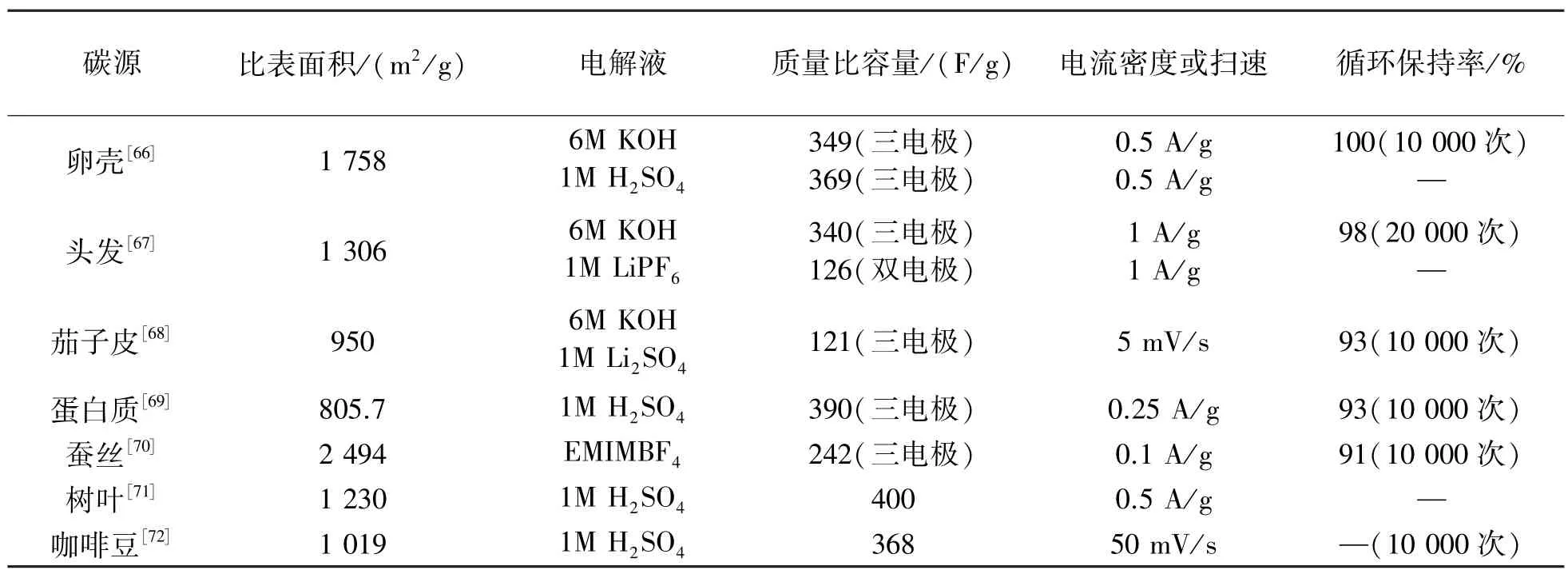
表1 不同碳源制备的多孔碳材料及其电化学性能Tab.1 Electrochemical performances of carbons derived from different carbon precursors
近年来,随着制备技术的发展,多孔碳基超级电容器的性能有了显著提高。Zhao等[66]通过以生物质卤虫卵壳做为碳源,在700℃下进行碳化,并用KOH进行活化得到了一种富氧(13.1%)三维多级孔道碳(HPC)材料。其比表面积达到了1 758 m2/g(其中微孔贡献了 78.7%),Barrett⁃Joyner⁃Halenda(BJH)孔径为2.62 nm。该电极材料在6M KOH电解液中测试的结果表明其质量比容量达到了349 F/g(0.5 A/g),在1M H2SO4中的质量比容量则高达369 F/g(0.5 A/g),并且表现出了很好的循环稳定性(10 000次恒流充放电循环后容量保持率为100%)。Qian等[67]以人的头发做为碳源在800℃下进行煅烧并用KOH进行活化制备了一种富含N(4.38%,质量分数,下同)、O(5.39%)、S(1.51%)等杂原子的多孔碳(HMCs)。其比表面积(BET)达到了1 306 m2/g(介孔贡献92.1%),孔容为0.9 cm3/g,平均孔径小3 nm。该电极材料在6M KOH电解液中的质量比容量达到了340 F/g(0.5 A/g),在20 000次充放电循环后其容量仍能保持在98%左右。将其组装为双电极体系在1M LiPF6电解液中进行测试,结果显示该电极材料质量比容量达到了126 F/g(0.5 A/g),0.1 A/g时能量密度高达45.33 Wh/kg。Li等[68]通过1 000℃高温碳化茄子皮制备了一种氮掺杂片状多孔碳(SPC)。其比表面积达到了950 m2/g,孔径尺寸分布在1~3 nm之间。在10 A/g的电流密度下充放电10 000次后容量保持率为93%,由于其薄片状结构提供了有利的离子传输通道,该材料表现出了非常高的倍率性能,在1 000 mV/s(相当于120 A/g)扫速下比容量仍可以保持在75%左右(相对于5 mV/s)。Huo等[70]将蚕丝在900℃下碳化并用ZnCl2进行活化得到了一种氮(4.7%)掺杂碳纳米片,其比表面积(BET)达到了2 494 m2/g,孔容为2.28 cm3/g,平均可孔径尺寸为4.6 nm,微孔孔径则集中分布在0.59~1.29 nm之间。该电极材料在 EMIMBF4(1⁃丁基⁃3⁃甲基咪唑四氟硼酸盐)电解液中的质量比容量达到了242 F/g(0.5 A/g),在10 000次充放电循环后其容量仍能保持为91%。在双电极体系中以EMIMBF4作为电解液进行测试结果表明其能量密度高达 90.0 Wh/kg,功率密度达到了8 750 W/kg。表1列出了不同碳源制备的多孔碳材料的电化学性能。
2.2 碳纳米管
碳纳米管(又称巴基管)(CNTs)是一种一维碳材料,属于富勒碳系,它是由呈六边形排列的碳原子所构成的单层至数十层的无缝同轴圆管。根据管壁层数不同可将碳纳米管分为单壁碳纳米管(SWCNTS)和多壁碳纳米管(MWCNTS)。其合成方法主要包括3种:①电弧法;②石墨激光蒸发法;③化学气相沉积法[73]。碳纳米管的直径一般在介孔范围内,非常有利于双电层的形成与电解质离子的迁移,其独特的中空结构、极高的强度、良好的柔韧性和导电性(取决于管壁与管径的螺旋角,当管径小于6 nm时,可以将其看作具有良好导电性的一维量子导线;当管径大于6 nm时,导电性会下降)及相互缠绕的纳米级网状结构,被认为是提高超级电容器倍率性能的一种理想的电极材料,在纳米电子器件、柔性光电器件等领域具有广阔的应用前景[74]。但是碳纳米管比表面积一般小于500 m2/g,成为了制约其构筑高能量密度超级电容器电极材料的重要因素,因此对其进行化学改性、构建三维碳纳米管有序阵列或与其他材料进行复合成为了解决这一缺陷的重要途径[75⁃76]。例如,Kaempgen等[77]将 0.1 mg/mL的CNTs分散于1%的十二烷基硫酸钠中,通过真空过滤得到了一种碳纳米管网络结构,并将其作为电极材料组装为双电极体系进行了电化学测试,在1M H2SO4电解液中的质量比容量可提高到33 F/g。
通过化学改性可以极大地改善碳纳米管的电化学性能。Yeh等[78]利用化学气相沉积法通过金属催化合成了一种多壁碳纳米管,并通过硼酸处理获得了B掺杂多壁碳纳米管。电化学测试结果表明该电极材料在50 mV/s扫速下质量比容量达到了40 F/g(不掺杂的为8.35 F/g)。而Ujjain等[79]等利用芳香族叠氮化合物通过1⁃3⁃双[3+2]环加成反应对多壁碳纳米管进行修饰引入了羧基等亲水官能团。该功能化的多壁碳纳米管通过喷墨打印的方法转移到PET基板上作为电极,全氟磺酸作为隔膜组装了超级电容器,并分别在0.1M ACN(乙腈)+TBAP(四丁基高氯酸氨)有机电解液和1M Na2SO4、1M H2SO4和1M KOH等水系电解液中进行了电化学性能测试,其中在1M H2SO4电解液中,0.5 A/g电流密度下最高能量密度达到了57.8 Wh/kg,功率密度达到了0.85 kW/kg,在经过1 000次充放电循环后容量和功率分别保持在85%~94%和95%。Niu等[80]报道了一种利用硝酸预处理的碳纳米管电极材料。其比表面积为430 m2/g,在酸性电解液中质量比容量达到102 F/g。Hiraoka等[81]通过对碳纳米管进行氧化改性得到一种比表面积超过2 200 m2/g的电极材料。Zhou等[82]通过将(CH3CN)和NH4BF4加入苯溶液中,以CTAB为模板,利用溶剂热的方法,在400℃下保温1 h合成了一种垂直生长的B、N共掺杂的碳纳米管阵列(VA⁃BC2NNTA)。该纳米管阵列具有整齐的由极性键组成的孔通道,不仅有利于双电层的形成,而且有效地促进了电解质离子的传输,与此同时该纳米管筒状结构为电解质离子的传输提供了较大的比表面积和丰富的活性位点。在6M KOH电解液中经电化学测试,表明该纳米管阵列电极材料在0.2 A/g的电流密度下质量比容量高达574 F/g(是目前所合成碳材料的2~6倍),经过3 500次充放电循环后仅有3%的容量损失。Iyyamperumal等[83]以三聚氰胺为前驱物加入硼酸作为掺杂源,并以镀有Fe/Ni(5 nm/5 nm)的SiO/Si为基片,在1 000℃高温条件下(Ar/H2混合气氛下)合成了垂直生长的BCN纳米管阵列。电化学测试表明,该掺杂碳纳米管电极材料在1M H2SO4电解液中质量比容量达到了312 F/g,在6M KOH电解液中达到了321 F/g,1 000次充放电循环后容量仅损失5%。
在有机体系中碳纳米管电极材料可以同时获得高能量密度和高功率密度。Lu等[84]以镀有3 nm厚Fe催化剂的SiO2/Si为基板,以24%的乙炔气为碳源在750℃下合成出了一种碳纳米管阵列。将其组装为双电极装置在[EMIM][Tf2N](1⁃乙基⁃3⁃甲基咪唑双三氟甲磺酰亚胺盐)电解液中进行电化学测试,结果表明其测试电压可达4 V,质量比容量为440 F/g,当扫速从5 mV/s增加到100 mV/s时容量仍然可以保持为75%,最大能量密度达到了148 Wh/kg,最大功率密度达到了315 kW/kg。然而作为超级电容器电极材料,目前碳纳米管工业化生产技术还不成熟,生产成本较高,还具有很大的研究空间。
2.3 石墨烯
石墨烯(Graphene)是一种由单层碳原子(0.334 nm)组成的二维六边形晶体,可以作为制备富勒烯和碳纳米管的母体[85⁃87]。其传统制备方法主要包括机械剥离法、化学气相沉积、SiC热解、氧化石墨烯还原等。石墨烯具有极高的导电性、导热性、较高的比表面积、非常好的化学稳定性和较强的机械强度等优点,因此在储能、光催化和化学传感等领域潜在应用价值巨大。它固有的规整结构组成、易接近的孔和夹层空间非常有利于离子的传输[88]。对于二维石墨烯而言,由于层间距非常小,在层与层之间的∏—∏键作用力下会不可避免地发生堆叠和团聚从而极大地影响了其电化学性能[89]。三维石墨烯不仅具有二维石墨烯固有性质,而且具有良好的结构稳定性和多级孔道结构,这种结构更有利于电解质离子的传输与能量的储藏。近年来人们对掺杂石墨烯、三维多孔自支撑石墨烯、石墨烯复合材料的研究越来越多,其在水系、有机体系、全固态体系等超级电容器领域的应用也取得了较大的进展,不同石墨烯的性质与电化学性能如表2所示。
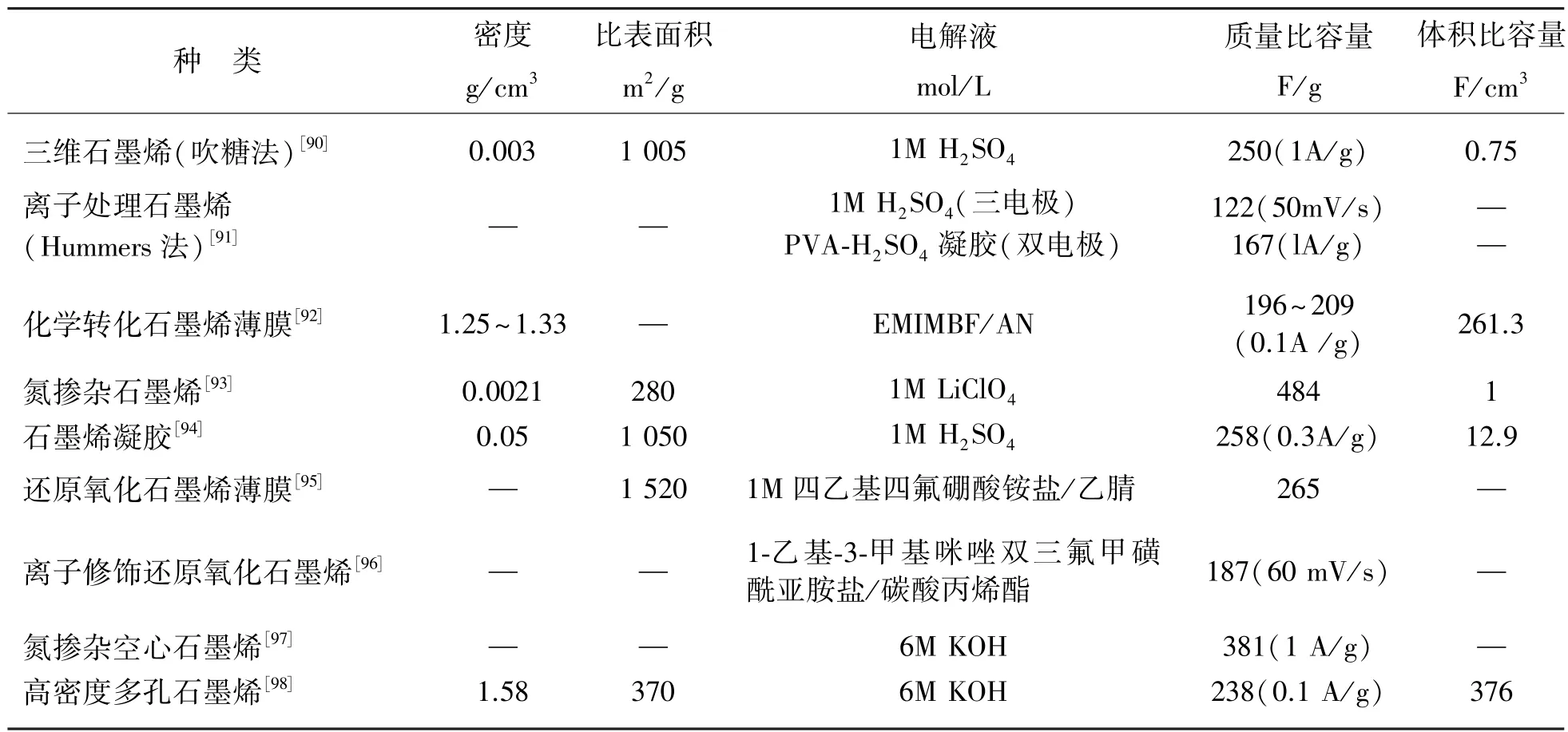
表2 不同石墨烯的性质与电化学性能Tab.2 Physical and electrochemical properties of different kinds of graphene
Wang等[90]运用葡萄糖和氯化铵混合,并通过 煅烧使蔗糖转变为类黑精中间体,在铵盐高温下分解产生的气体作用下不断膨胀变薄,在1 350℃高温下转化为三维石墨烯。该三维石墨烯的质量密度只有 0.003 g/cm3,比表面积达到了 1 005 m2/g,平均孔径尺寸为12 nm。在1M H2SO4电解液进行电化学测试显示其质量比容量达到了250 F/g(1 A/g),在100 A/g的电流密度下比容量仍能达到130 F/g,功率密度更是高达893 kW/kg。Kim等[96]对还原氧化石墨烯进行离子处理并将其作为双电层电极材料应用在有机体系超级电容器中,其最高电压可以达到3.5 V,电化学测试结果显示其质量比容量为 187 F/g,功率密度高达2.4 kW/kg。Fan等[97]将氧化石墨烯、聚苯胺分别逐层包覆在聚苯乙烯纳米球表面并通过热解合成了一种氮掺杂空心结构石墨烯。在1 A/g的电流密度下该石墨烯电极材料的质量比容量达到了381 F/g,当电流密度达到20 A/g时其比容量仍然可达282 F/g,同时表现出非常好的循环稳定性(5 000次充放电循环后容量可以保持为96%)。
2.4 碳微球
碳微球(CMs)是一种球形结构碳材料。分为石墨化和非石墨化两种;按结构又可以分为实心球、空心球和核壳球。目前其制备方法主要包括:溶剂热法、CVD法、模板法、球磨法、乳化法等。用于超级电容器的电极材料像多孔碳、石墨烯等一般具有较高的质量比容量,但由于其密度(<0.75 g/cm3)比较低,导致其体积比容量一般小于200 F/cm3。当前电子器件越来越向微小化、便携等方向发展,所以电极材料的体积比容量也是评价其储能性能的重要参数。因此,为了提高体积比容量,需要制备低比表面积,高比容量的碳材料。碳微球具有较高的堆积密度、较好的流动性、良好的导电性和较易控制的孔径,是一种出色的超级电容器电极材料[99⁃102]。目前对碳微球电极材料的研究主要集中在提高其堆积密度、改善表面结构、掺杂改性和提高导电性等方面。
Qiang等[103]以马铃薯淀粉为碳源在180℃下采用水热法合成出了碳微球,并将其在900℃氮气氛围下进行碳化。所得碳球平均粒径为250 nm且比较均匀,比表面积达到了456 m2/g。电化学测试结果表明该电极材料在1M KOH电解液中的质量比容量为245 F/g(1 A/g),经过4 000次充放电循环,其容量仍能保持为98%。Zhu等[104]利用聚二氨基萘(PDAN)直接碳化制得了含氮(5.94%,原子分数)碳微球。该含氮碳微球比表面积为403 m2/g,经电化学测试表明在6M KOH电解液中当电流密度为1 A/g时,质量比容量达228 F/g,在经5 000次充放电循环之后,可保持在190 F/g(86%)。Ferrero等[105]以 SiO2(负载有FeCl3)微球作为模板,在密闭容器中将吡咯蒸汽作为含氮碳源沉积(25℃下反应22 h)在模板上,通过高温煅烧后利用氢氟酸(48%)将模板刻蚀掉,从而得到了一种氮掺杂(9%)多孔碳微球。该碳微球比表面积在1 300 m2/g左右,堆积密度为0.97 g/cm3,在1M H2SO4电解液中体积比容量高达290 F/cm3,能量密度和功率密度也分别达到了12 Wh/L和19 kW/L。利用KOH对该碳微球进行活化后大大增加了其微孔网状结构,比表面积上升到2 690 m2/g,但是氮含量下降到了2%左右,其在TEAF4(四乙基四氟硼酸铵盐)/AN(丙烯腈)电解液中的体积比容量可以达到92 F/cm3,能量密度和功率密度也分别达到了15 Wh/L和4 kW/L。Chen等[106]利用间苯二酚/甲醛树脂为碳源通过100℃水热 24 h制备了一种碳球,并以K3[Fe(CN)6]为催化剂将其在1 000℃下进行催化得到了石墨化的碳微球。该碳球的平均尺寸为625 nm,在除去铁离子后碳球上遍布100 nm左右的介孔,使比表面积达到了381 m2/g。由于其较高的石墨化程度和丰富的多级孔结构,作为超级电容器电极材料表现出了优异的性能。电化学测试结果表明该电极材料在10 mV/s的扫速下质量比容量达到了155 F/g。
最近,Zhou等[107]采用低温溶剂热法在不加入任何金属催化剂的条件下一步合成出了氮、氟共掺的低比表面积(1.4 m2/g)、高堆积密度石墨化碳微球(CM⁃NF)电极材料,该材料具有超高的体积比电容,高达521 F/cm3,是商业活性碳的3倍,为目前已报道的碳基材料中的最高值。该掺杂碳微球电极材料利用氮掺杂产生赝电容来提高电容量,利用氟掺杂来增强电子导电性,基于氮、氟共掺的协同效应,来改善材料的电子给体/受体特性,从而使得制备的碳微球呈现出极高的体积比容量。同时,制得的碳微球在5 A/g的电流密度下进行循环充放电10 000次,其电容量几乎没有损失,展示出极高的稳定性。这一工作为设计新型高效的高体积比容量电极提供了新思路。如此性能优良的电极材料有望在紧凑型储能装置的开发中发挥重要应用。
2.5 碳⁃碳复合材料
单一碳材料往往不能兼备多种优良的电化学特性,复合材料的出现成为一种必然。比如多孔碳一般具有非常大的比表面积、多级孔通道和丰富的表面基团,从而具有很高的比容量,但是其导电性、柔韧性等性能仍然需要提高;碳纳米管导电性能和柔韧性比较出色,但是比表面积一般并不高,严重限制了其作为高能量密度超级电容器电极材料的应用;石墨烯具有极高的导电性能和较高的比表面积,但是由于大π键作用力的影响非常容易发生团聚。因此,通过复合不仅可以解决单一碳材料的弊端,而且何以使复合材料兼具各自的优良特性。
Zhu等[108]将镍离子负载于有序介孔碳上,并通过CVD沉积的方法在其上面生长出了碳纳米管,合成了三维有序介孔碳/碳纳米管复合材料。该复合电极材料表现出了较高比容量和较好的倍率性能。在6M KOH电解液中进行电化学测试结果表明,当电流密度为1 A/g时其质量比容量高达338.1 F/g,当电流密度为50 A/g时,仍能达到130 F/g。在经过4 000次充放电循环后,其容量可保持为91.6%。其能量密度为46.9 Wh/kg(为纯介孔碳的1.6倍)时,功率密度达到了500 W/kg;而当能量密度为18.1 Wh/kg时,功率密度则高达25 kW/kg,与此同时纯介孔碳的能量密度和功率密度分别只有15.4 Wh/kg和15 kW/kg。Zeng等[109]利用多壁碳纳米管通过超声氧化剪切的方法得到了一种超短的碳纳米管,并将其与氧化石墨烯进行复合,再通过肼还原制备了一种碳纳米管/还原氧化石墨烯复合电极材料。该电极材料碳纳米管的引入构建了一种3D多层结构,解决了石墨烯堆叠的问题,并且表现出了很好的电化学性能。在1M H2SO4电解液中循环伏安测试结果表明,扫速为50 mV/s时其质量比容量达到了244 F/g(RGO质量比容量为136 F/g),当扫速上升到1 000 mV/s时比容量仍然可以保持为210 F/g(85%)。Zhang等[110]通过利用苯酚和甲醛混合物做为碳源,控制其与氧化石墨烯的质量比例为16∶1进行混合。将混合物热解碳化,并进行活化,之后得到了一种三维多孔石墨烯基块体碳材料。该碳材料比表面积高达3 523 m2/g,并且具有非常出色的导电性能。在离子型电解液(EMIMBF4)中进行电化学测试结果表明该电极材料的质量比容量、能量密度和功率密度分别达到了231 F/g、98 Wh/kg和137 kW/kg,质量比容量和能量密度为已报道过的所有块体碳材料中的最高值。
2.6 其它碳材料
碳材料种类丰富多样,除上述碳材料外,可用于超级电容器的碳材料还包括像碳纤维、玻璃碳、碳黑、碳气凝胶等。目前对于这些碳材料的研究主要集中在通过改进实验方案使材料的形貌可控、生产成本低、比表面积大、电化学性能好等方面。
3 碳基超级电容器发展趋势
综上所述,碳材料作为超级电容器主要电极材料取得了快速的发展,多孔碳、碳纳米管、石墨烯、碳微球等多种先进碳材料被成功地应用于超级电容器领域。碳基材料超级电容器发展趋势如图4所示,在经历水系、有机体系、全固态体系的同时也正在由对称型向非对称型进行转变。
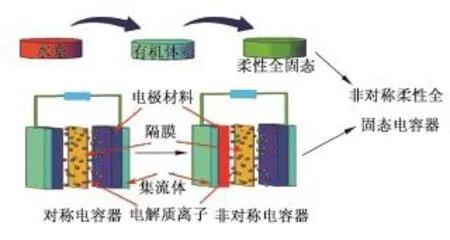
图4 碳基超级电容器发展趋势图Fig.4 Schematic illustration of the development for carbon⁃based supercapacitors
关于高能量超级电容器的研究集中在提高电极材料的比电容及电位窗口两方面。根据公式E=1/2CU2,超级电容器的能量密度(E)由比电容(C)和电位窗口(U)决定。但是,正负极均采用碳材料的对称型碳基超级电容器往往具有较低的能量密度,限制了其在更广范围内的应用。将两类分别具有赝电容和双电层电容储能特性的不同种类材料分别作为超级电容器的正负极材料构造非对称超级电容器,不仅可以大大提高电容器的比电容,还可以充分利用两种材料不同的电位窗口,可显著提高电容器的能量密度[111⁃113]。但是这类超级电容器大多以牺牲其功率密度和循环稳定性为代价,具有优越导电性和稳定性的高性能赝电容材料仍然有待开发。
此外,开发具有较高电位窗口的新型电解液也是改善超级电容器能量密度的有效途径。现有超级电容器电解液可分为水系(碱性KOH;酸性H2SO4;中性 NaSO4、Li2SO4)[2],[7],[114⁃119];有机体系(四乙基四氟硼酸铵/乙腈(Et4NBF4/AN)、四乙基四氟硼酸铵/丙烯碳酸酯(Et4NBF4/PC)、六氟磷锂/碳酸乙烯酯(LiPF6/EC)、四乙基四氟硼酸铵盐/丙烯腈(TEAF4/AN)、1⁃丁基⁃3⁃甲基咪唑四氟硼酸盐(EMIMBF4)、1⁃乙基⁃3⁃甲基咪唑双三氟甲磺酰亚胺盐/碳酸丙烯酯 (Emim⁃Nif2/PC)等)[79],[84],[95⁃96],[116⁃127]和 全 固 态 (PVA/H2SO4、PVA/KOH、PVA/NaSO4等)[91],[128⁃136]等几种。表3详细列出了不同电解液体系在超级电容器中的应用,并对不同体系超级电容器的电位窗口及能量密度做了相应的概括。在目前所使用的超级电容器中,水系电容器具有比电容较高、制备方法简单、安全性好等优点,但电位窗口相对较小,只有1 V左右(水的分解电压为1.23 V),严重限制了能量密度的提高。有机体系电容器比容量相对较低,但是电势窗口可达到2~4.5 V,具有较高的能量密度,然而有机电解液存在诸多缺陷,如对使用条件要求比较高,一般需要密封,会降低材料比容量和电容器导电性等。随着纳米科技的迅速发展,柔性可穿戴电子产品在日常生活中正在扮演着越来越重要的角色。这种柔性电容器一般采用全固态电解质,不存在电解液泄漏、爆炸等危险;且电位窗口不受水的分解电压限制,可达3 V以上,具有能量密度高、功率密度大、充放电比较快、质量比较轻、绿色环保和使用寿命长等诸多优点,因此基于固态超级电容器的柔性能源储存装置的制备成为了研发新兴电子产品的关键。
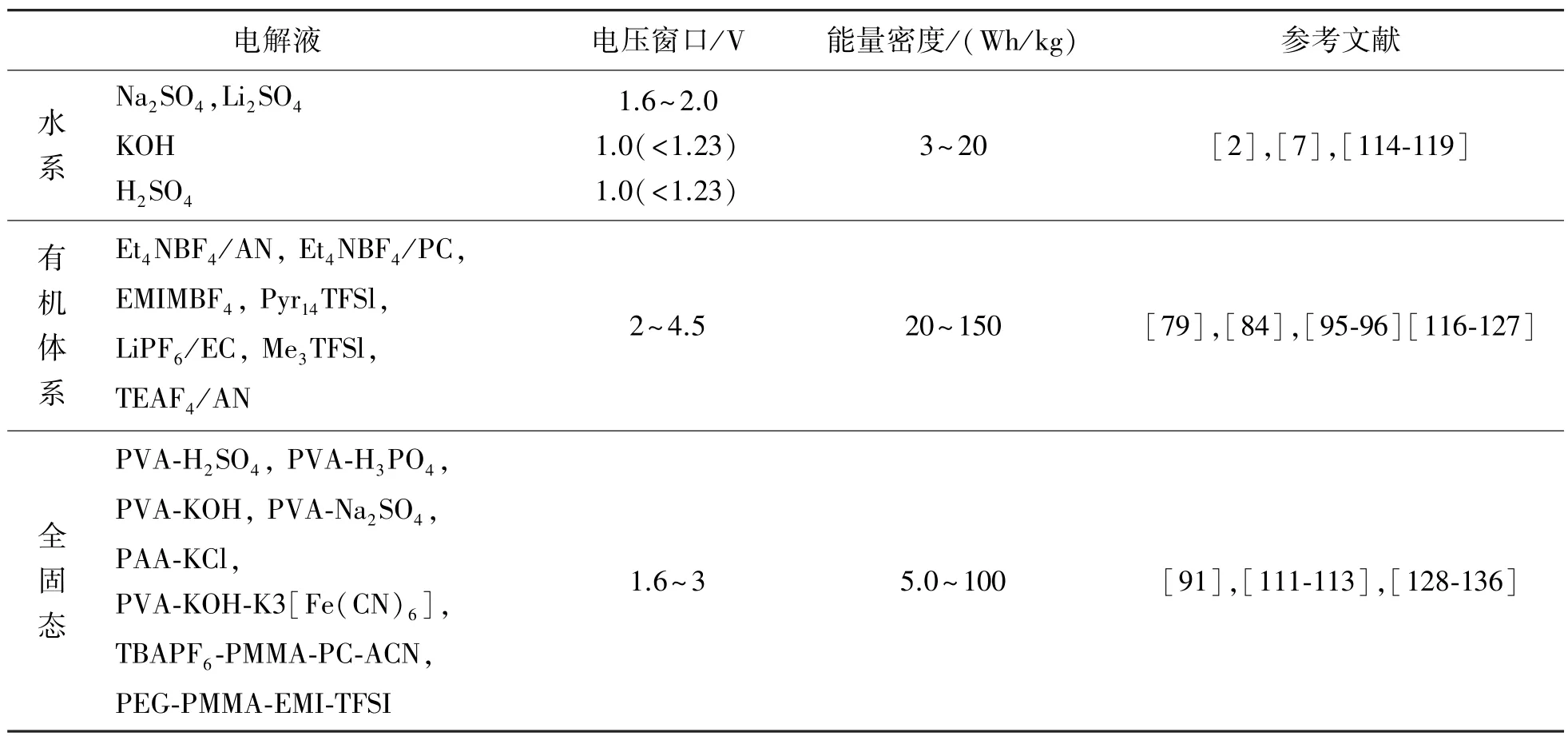
表3 超级电容器在不同电解液中的电位窗口及能量密度Tab.3 The potential window and energy density of supercapacitors in different electrolytes
应用于柔性全固态超级电容器的电极材料通常具有非常好的柔韧性和拉伸性能,如碳纳米管、石墨烯等。Yuksel等[135]将单壁碳纳米管沉积在聚二甲硅氧烷基片上作为电极片,并以TBAPF6(四丁基⁃六氟磷酸铵)∶PMMA(聚甲基丙烯酸甲酯) ∶PC(碳酸丙烯酯):ACN(乙腈)按3∶7∶20∶70比例混合制备的凝胶作为电解质,组装了柔性全固态超级电容器装置。电化学测试结果表明其质量比容量达到了22.2 F/g,功率密度达到了41.5 kW/kg,在经过500次充放电循环后容量可以保持为94%。Hu等[136]将单壁碳纳米管用浓硫酸和浓硝酸混合液(3∶1)处理使其官能团化。将其涂覆于纯棉纤维纸上作为电极片,并利用PVA(6 g)/磷酸(1.6 g)作为电解质组装了一种柔性全固态超级电容器。其充电电压可以超过3 V,最大质量比容量达到了115.83 F/g,能量密度高达48.86 Wh/kg。Choi等[91]利用Hummers法制备了石墨烯并用离子液(C4mimBF4)(1⁃丁基⁃3⁃甲基咪唑四氟硼酸盐)对其进行化学处理改性,得到的材料作为负极材料,将得到的石墨烯与RuO2进行复合作为正极材料,用PVA⁃H2SO4凝胶作为电解质组装了一种全固态超薄的柔性非对称超级电容器。该超级电容器电压可以达到1.8 V,能量密度和功率密度分别可以达到 19.7 Wh/kg和6.8 kW/kg。比容量在10 A/g的电流密度下仍可以保持在79.4%,经过2 000次充放电循环后其容量损失仅为5%。
4 展望
总之,碳基超级电容器近年来取得了长足的发展,并已经在多个领域显示出广阔的市场前景与巨大的应用价值。通过制备同时具有高质量和高体积电容密度的碳材料、改善电解液性能提高电解液分解电压、组装非对称或全固态超级电容器等提高碳基电容器的能量密度而不以牺牲电容器的功率密度和循环寿命为代价等,是提高超级电容器性能的主要方法。随着材料科学和电子工艺的迅猛发展,像一些柔性显示器、电子书、掌上电脑、智能手机等柔性电子器件正在不断融入人们的生活。相比于液态超级电容器,全固态超级电容器具有轻薄、小巧、结构简单、便于携带、安全系数高等优点,在可穿戴式电子产品领域具备非常诱人的应用前景。因此,设计与研发高机械性能的柔性碳电极材料,制备兼具高体积能量密度及高质量能量密度的非对称柔性全固态超级电容器将成为研究的热点与趋势。
[1]Martin W,Brodd R J.What are batteries,fuel cells,and supercapac⁃itors[J].Chemical Reviews,2004,104(10):4245⁃4269.
[2]Burke A.Ultracapacitors:why,how,and where is the technology[J].Journal of Power Sources,2000,91(1):37⁃50.
[3]Miller J R,Simon P.Electrochemical capacitors for energy manage⁃ment[J].Science,2008,321(5889):651⁃652.
[4]Patil B H,Jagadale A D,Lokhande C D.Synthesis of polythiophene thin films by simple successive ionic layer adsorption and reaction(SILAR)method for supercapacitor application[J].Synthetic Met⁃ als,2014,162(15/16):1400⁃1405.
[5]Lewandowski A,Galinski M.Practical and theoretical limits for electrochemical double⁃layer capacitors[J].Journal of Power Sources,2007,173(2):822⁃828.
[6]Bohlen O,Kowal J,Sauer D U.Ageing behavior of electrochemical double layer capacitors[J].Journal of Power Sources,2007,172(1):468⁃475.
[7]Simon P,Gogotsi Y.Materials for electrochemical capacitors[J]. Nature Materials,2008,7(11):845⁃854.
[8]Simon P,Gogotsi Y.Capacitive energy storge in nanostructured ca⁃bon⁃electroyte systems[J].Chemical Research,2013,46(5):1094⁃1103.
[9]Miller J,Burke A F.Electrochemical capacitors:challenges and op⁃portunities for real⁃world applications[J].Electrochemical Society Interface,2008,17(1):53⁃57.
[10]Yuan C Z,Gao B,Shen L F,et al.Hierarchically structured carbon⁃based composites:Design,synthesis and their application in electrochemical capacitors[J].Nanoscale,2011,3(2):529⁃545.
[11]Jiang H,Ma J,Li C Z.Mesoporous carbon incorporated metal oxide nanomaterials as supercapacitor electrodes [J].Advanced Materials,2012,24:4197⁃4202.
[12]Wang G P,Zhang L,Zhang J J.A review of electrode materials for electrochemical supercapacitors[J].Chemical Society Reviews,2012,41(2):797⁃828.
[13]Choi N S,Chen Z H,Freunberger S A,et al.Challenges facing lithium batteries and electrical doublelayer capacitors[J].Ange⁃wandte Chemie International Edition,2012,51(40):9994⁃10024.
[14]Wen Z H,Li J H.Hierarchically structured carbon nanocomposites as electrode materials for electrochemical energy storage,conversion and biosensor or systems[J].Journal of Materials Chemistry,2009,19(46):8707⁃8713.
[15]Pognon G,Brousse T,Belanger D.Effect of molecular grafting on the pore size distribution and the double layer capacitance of acti⁃vated caron for electrochemical double layer capacitors[J].Carbon,2011,49(4):1340⁃1348.
[16]Barbieri O,Hahn M,Herzog A,et al.Capacitangce limits of high surface area actived carbons for double layers capacitors[J]. Carbon,2005,43(6):1303⁃1310.
[17]Pietrzak R,Jurewicz K,Nowieki P,et al.Microporous activated carbons from ammoxidised anthracite and their capacitance behav⁃iours[J].Fuel,2007,86(7/8):1086⁃1092.
[18]Chen L F,Zhang X D,Liang H W,et al.Synthesis of nitrogen⁃doped porous carbon nanofibers as an efficient electrode material for supercapacitors[J].ACS Nano,2012,6(8):7092⁃7102.
[19]Jurewicz K,Babel K,Ziolkowski A,et al.Ammoxidation of active carbons for improvement of supercapacitor characteristics[J].Elec⁃trochimca Acta,2003,48(11):1491⁃1498.
[20]Wang H L,Gao Q M,Hu J,et al.High performance of nanoporous carbon in cryogenic hydrogen storage and electrochemical capaci⁃tance[J].Carbon,2009,47(9):2259⁃2268.
[21]Kleinsorge B,Ferrari A C,Robertson J,et al.Influence of nitrogen and temperature on the deposition oftetrahedrally bonded amorphous carbon[J].Journal of Applide Phydics,2000,88(2):1149⁃1157.
[22]Zhao X C,Wang A Q,Yan J W,et al.A publication fo the ameri⁃can chemical society[J].Chemistry of Materials,2010,22(19):5463⁃5473.
[23]Pietrzak R,Jurewicz K,Nowieki P,et al.Microporous activated carbons from ammoxidised anthracite and their capacitance behav⁃iours[J].Fuel,2007,86(7/8):1086⁃1092.
[24]Hulicova⁃Jurcakova D,Puziy A M,Poddubnaya O I,et al.Highly stable performance of supercapacitors from phosphorus⁃enriched carbons[J].Journa of the American Chemical Society,2009,131(14):5026⁃5027.
[25]Hulicova⁃Jurcakova D,Seredych M,Gao Q L,et al.Combined effect of nitrogen⁃and oxygen⁃containing functional groups of microporous activated carbon on its electrochemical performance in supercapacitors[J].Advanced Functional Materials,2009,19(3):438⁃447.
[26]Beguin F,Szostak K.A self⁃supporting electrode for supercapacitors prepared by one⁃step pyrolysis of carbon nanotube/polyacrylonitrile blends[J].Advanced Materials,2005,17(19):2380⁃2384.
[27]Stein A,Wang Z Y,Fierke M A.Functionalization of porous carbon materials with designed pore architecture[J].Advanced Ma⁃terials,2009,21(3):265⁃293.
[28]Kwon T,Nishihara H,Itoi H,et al.Enhancement mechanism of electrochemical capacitance in nitrogen/boron⁃doped carbons with uniform straight nanochannels[J].Langmuir,2009,25(19):11961⁃11968.
[29]Lota G,Grzyb B,Machnikowska H,et al.Effect of nitrogen in car⁃bon electrode on the supercapacitor performance[J].Chemical Physics Letters,2005,404(1):53⁃58.
[30]ShiraishiS,Mamyouda H.Electrochemicalcapacitance of carbonized polyaniline[J].TANSO,2008,46(7):1110⁃1110.
[31]KawaguchiM,Itoh A,YagiS,etal.Preparation and characterization of carbonaceous materials containing nitrogen as electrochemical capacitor[J].Journal of Power Sources,2007,172(1):481⁃486.
[32]Derradji N E,Mahdjoubi M L,Belkhir H,et al.Nitrogen effect on the electrical properties of CNx thin films deposited by reactive magnetron sputtering[J].Thin Solid Films,2005,482(1):258⁃263.
[33]Kim J,Choi M,Ryoo R.Synthesis of mesoporous carbons with con⁃trollable N⁃content and their supercapacitor properties[J].Bulletin of the Korean Chemical Society,2008,29(22):413⁃416.
[34]Beguin F,Szostak K,Lota G,et al.A self⁃supporting electrode for supercapacitors prepared by one⁃step pyrolysis of carbon nanotube/polyacrylonitrile blends[J].Advanced Materials,2005,17(19):2380⁃2384.
[35]Hulicova D,Yamashita J,Soneda Y,et al.Supercapacitors prepared from melamine⁃based carbon[J].Chemical Materials,2005,17(5):1241⁃1247.
[36]Conway B E.Electrochemical supercapacitors,scientific fundamen⁃tals and technological applications[M].New York:Springer,1999:1⁃727.
[37]Deyang Q.Studies of the activated carbons used in double⁃layer supercapacitors[J].Journal of Power Sources,2002,109(2):403⁃411.
[38]Nian Y R,Teng H.Nitric acid modification of activated carbon e⁃lectrodes for improvement of electrochemical capacitance[J]. Journal of the Electrochemical Society,2002,149(8):1008⁃1014.
[39]Ishikawa M,Sakamoto A,Monta M,et al.Effect of treatment of ac⁃tivated carbon fiber cloth electrodes with cold plasma upon perform⁃ance of electric double⁃layer capacitors[J].Journal of Power Sources,1996,60(2):233⁃238.
[40]Yoshida A,Tanahashi I,Nishino A.Effect of concentration of sur⁃face acidic functional groups on electric double⁃layer properties of activated carbon fibers[J].Carbon,1990,28(5):611⁃615.
[41]Nakamura M,Nakanishi M,Yamamoto K.Influence of physical properties of activated carbons on characteristics of electric double⁃layer capacitors[J].Journal of Power Sources,1996,60(2):225⁃231.
[42]Rychagov A Y,Urisson N A,Vol′fkovich Y M.Electrochemical characteristics and properties of the surface of activated carbon electrodes in a double⁃layer capacitor[J].Russian Journal of Elec⁃trochemistry,2001,37(11):1172⁃1179.
[43]Chen W C,Wen T C,Teng H.Polyaniline⁃deposited porous carbon electrode for supercapacitor[J].Electrochimica Acta,2003,48(6):641⁃649.
[44]Huang Q,Wang X,Li J,et al.Nickel hydroxide/activated carbon composite electrodes for electrochemical capacitors[J].Journal of Power Sources,2007,164(1):425⁃429.
[45]Kim I H,Kim J H,Cho B W,et al.Pseudocapacitive properties of electrochemically prepared vanadium oxide on carbon nanotube film substrate[J].Journal of the Electrochemical Society,2006,153(8):1451⁃1458.
[46]Kotz R,Carlen M.Principles and applications of electrochemical capacitors[J].Electrochim Acta,2000,45(15):2483⁃2498.
[47]Frackowiak E,Bguin F.Carbon materials for the electrochemical storage of energy in capacitors[J].Carbon,2001,39(6):937⁃950.
[48]Fischer A E,Pettigrew K A,Rolison D R,et al.Incorporation of homogeneous,nanoscale MnO2within ultraporous carbon structures via self⁃limiting electroless deposition:Implications for electrochem⁃ical capacitors[J].Nano Letters,2007,7(2):281⁃286.
[49]Tanaka S,Nakao H,Mukai T,et al.An experimental investigation of the ion storage/transfer behavior in an electrical double⁃layer ca⁃pacitor by using monodisperse carbon spheres with microporous structure[J].Journal of Physical Chemistry,2012,116(51):26791⁃26799.
[50]Kim H,Fortunato M E,Xu H X,et al.Carbon microspheres as su⁃percapacitors[J].Journal of Materials Chemistry,2011,115(42):20481⁃20486.
[51]Liu M X,Gan L H,Xiong W,et al.Nickel⁃doped activated meso⁃porous carbon microspheres with partially graphitic structure for su⁃percapacitors[J].Energy Fuels,2012,27(2):1168⁃1173.
[52]Liu M X,Ma X M,Gan L H,et al.A facile synthesis of a novel mesoporous Ge@C sphere anode with stable and high capacity for lithium ion batteries[J].Journal of Materials Chemistry A,2014,2(40):17107⁃17114.
[53]Ma X M,Gan L H,Liu M X,et al.Mesoporous size controllable carbon microspheres and their electrochemical performances for su⁃percapacitor electrodes[J].Journal of Materials Chemistry A,2014,2(22):8407⁃8715.
[54]Zhu D Z,Wang Y W,Gan L H,et al.Nitrogen⁃containing carbon microspheres for supercapacitor electrodes[J].Electrochim Acta,2015,158:166⁃174.
[55]Lee J,Kim J,Hyeon T.Recent progress in the synthesis of porous carbon materials[J].Advanced Materials,2006,18(16):2073⁃2094.
[56]Zhao N Q,Wu S,He C N,et al.Hierarchical porous carbon with graphitic structure synthesized by a water soluble template method[J].Materials Letters,2012,87(22):77⁃79.
[57]Liu C J,Liang X Y,Liu X J,et al.Wettability modification of pitch⁃based spherical activated carbon by air oxidation and its effects on phenol adsorption[J].Applied Surface Science,2008,254(9):2659⁃2665.
[58]An K H,Kim W S,Park Y S,et al.Electrochemical properties of high⁃power supercapacitors using single⁃walled carbon nanotube e⁃lectrodes[J].Advanced Functional Materials,2001,11(5):387⁃392.
[59]Frackowiak E,Jurewicz K,Delpeux S,et al.Nanotubular materials for supercapacitors[J].Journal of Power Sources,2001,97⁃98:822⁃825.
[60]Xia J L,Chen F,Li J H,et al.Measurement of the quantum capac⁃itance of graphene[J].Nature Nanotechnol,2009,4(8):505⁃509.
[61]Hirsch A.The era of carbon allotropes[J].Nature Material,2010,9(11):868⁃871.
[62]Geim A K.Graphene:Status and prospects[J].Science,2009,324(5934):1530⁃1534.
[63]Novoselov K S,Fal′ko V I,Colombo L,et al.A roadmap for gra⁃phene[J].Nature,2012,490(7419):192⁃200.
[64]Ren W C,Cheng H M.The global growth of graphene[J].Nature Nanotechnology,2014,9(10):726⁃730.
[65]Zhang Y,Feng H,Wu X B.Progress of electrochemical capacitor e⁃lectrode materials[J].International of Hydrogen Energy,2009,34(11):4889⁃4899.
[66]Zhao Y F,Ran W,He J,et al.Oxygen⁃rich hierarchical porous car⁃bon derived from artemia cyst shells with superior electrochemical performance[J].ACS Applied Materials&Interfaces,2015,7(2):1132⁃1139.
[67]Qian W,Sun F,Xu Y,et al.Human hair⁃derived carbon flakes for electrochemical supercapacitors [J].Energy Environmental Science,2014,7(1):379⁃386.
[68]Li Z J,Lv W,Zhang C.A sheet⁃like porous carbon for high⁃rate su⁃percapacitors produced by the carbonization of an eggplant[J].Car⁃bon,2015,92:11⁃14.
[69]Li Z,Xu H,Tan X,et al.Mesoporous nitrogen⁃rich carbons derived from protein for ultra⁃high capacity battery anodes and supercapaci⁃tors[J].Energy Environmental Science,2013,6(3):871⁃878.
[70]Hou J H,Cao C B,Idrees F,et al.Hierarchical porous nitrogen⁃doped carbon nanosheets derived from silk for ultrahigh⁃capacity battery anodes and supercapacitors[J].ACS Nano,2015,9(3):2556⁃2564.
[71]Biswal M,Banerjee A,Deo M,et al.From dead leaves to high energy density supercapacitors[J].Energy Environmental Science,2013,6(4):1249⁃1259.
[72]Rufford T E,Hulicova⁃Jurcakova D,Zhu Z,et al.Nanoporous carbon electrode from waste coffee beans for high performance su⁃percapacitors[J].ElectrochemistryCommunications,2008,10(10):1594⁃1597.
[73]Szabó A,Perri C,Csató A,et al.Synthesis methods of carbon nano⁃tubes and related materials[J].Materials,2010,3(5):3092⁃3140.
[74]Basirico L,Lanzara G.Moving towards high⁃power,high⁃frequency and low⁃resistance CNT supercapacitors by tuning the CNT length,axial deformation and contact resistance[J].Nanotechnology,2012,23(30):305401⁃305413.
[75]Singh P,Campidelli S,Giordani S,et al.Organic functionalization and characterization ofsingle⁃walled carbon nanotubes [J]. Chemical Society Review,2009,38(8):2214⁃2230.
[76]Hirsch A.Functionalization of single⁃walled carbon nanotubes[J]. Angewangdte Chemie InternationalEdition,2002,41(11):1853⁃1859.
[77]Kaempgen M,Ma J,Gruner G,et al.Bifunctional carbon nanotube networks for supercapacitors[J].Applied Physics Letters,2007,90(27):264104⁃264140.
[78]Yeh M H,Lin L Y,Leu Y A,et al.Synthesis of boron⁃doped multi⁃walled carbon nanotubes by an ammonia⁃assisted substitution reac⁃tion for applying in supercapacitors[J].Energy Procedia,2014,61:1764⁃1767.
[79]Ujjain S K,Bhatia R,Ahuja P,et al.Highly conductive aromatic functionalized multi⁃walled carbon nanotube for inkjet printable high performance supercapacitor electrodes[J].Plos One,2015,10(7):1⁃12.
[80]Niu C,Sichel E K,Hoch R,et al.High power electrochemical ca⁃pacitors based on carbon nanotube electrodes[J].Applied Physics Letters,1997,70(11):1480⁃1482.
[81]Hiraoka T,Izadi⁃Najafabadi A,Yamada T,et al.Compact and light supercapacitor electrodes from a surface⁃only solid by opened carbon nanotubes with 2 200 m2g-1surface Area[J].Advanced Materials,2010,20(3):422⁃428.
[82]Zhou J,Li N,Gao F,et al.Vertically⁃aligned BCN nanotube arrays with superiorperformancein electrochemicalcapacitors[J]. Scientific Reports,2014,4:6083⁃6083.
[83]Iyyamperumal E,Wang S Y,Dai L M.Vertically aligned BCN nanotubes with high capacitance[J].ACS Nano,2012,6(6):5259⁃5265.
[84]Lu W,Qu L T,Henry K,et al.High performance electrochemical capacitors from aligned carbon nanotube electrodes and ionic liquid electrolytes[J].Journal of Power Sources,2009,189(2):1270⁃1277.
[85]Morozov S V,Geim A K,Crigorieva I V,et al.Electric field effect in atomically thin carbon films[J].Science,2004,306(5696):666⁃669.
[86]Novoselov K S,Geim A K,Morozov S V,et al.Two⁃dimensional gas of massless dirac fermions in grapheme[J].Nature,2005,438(7056):197⁃200.
[87]Yin Z,Zhu J,He Q,et al.Graphene⁃based materials for solar cell applications[J].Advanced Energy Materials,2014,4(1):1⁃19.
[88]Qu Q T,Yang S B,Feng X L.2D Sandwich⁃like sheets of iron oxide grown on graphene as high energy anode material for superca⁃pacitors[J].Advanced Materials,2011,23(46):5574⁃5580.
[89]Stankovich S,Dikin D A,Piner R D,et al.Synthesis of graphene⁃based nanosheets via chemical reduction of exfoliated graphite oxide[J].Carbon,2007,45(7):1558⁃1565.
[90]Wang X,Zhang Y,Zhi C,et al.Three⁃dimensional strutted graphene grown by substrate⁃free sugar blowing for high⁃power⁃den⁃sity supercapacitors[J].Nature Communications,2013,4(4):1294⁃1296.
[91]Choi B G,Chang S J,Kang H W,et al.High performance of a sol⁃id⁃state flexible asymmetric supercapacitor based on graphene films[J].Nanoscale,2012,4(16):4983⁃4988.
[92]Yang X,Cheng C,Wang Y,et al.Liquid⁃mediated dense integration of graphene materials for compact capacitive energy stor⁃age[J].Science,2013,341(6145):534⁃537.
[93]Stoller M D,Park S J,Zhu Y W,et al.Graphene⁃based ultracapaci⁃tors[J].Nano Letters,2008,8(10):3498⁃3502.
[94]Wu Q,Sun Y Q,Bai H,et al.High⁃performance supercapacitor electrodes based on graphene hydrogels modified with 2⁃aminoan⁃thraquinone moieties[J].Physical Chemistry Chemical Physics,2011,13(23):11193⁃11198.
[95]El⁃Kady M F,Strong V,Dubin S.et al.Laser scribing of high⁃per⁃formance and flexible graphene⁃based electrochemical capacitors[J].Science,2012,335(6074):1326⁃1330.
[96]Kim T Y,Lee H W,Stoller M,et al.High⁃performance supercapaci⁃tors based on poly(ionic liquid)⁃modified graphene electrodes[J]. ACS Nano,2011,5(1):436⁃442.
[97]Fan W,Xia Y Y,Tjiu W W,et al.Nitrogen⁃doped graphene hollow nanospheres as novel electrode materials for supercapacitor applica⁃tions[J].Journal of Power Sources,2013,243(6):973⁃981.
[98]Tao Y,Xie X,Lv W,et al.Towards ultrahigh volumetric capaci⁃tance:Graphene derived highly dense but porous carbons for super⁃capacitors[J].Scientific Reports,2013,3(7471):2975⁃2975.
[99]Kim H,Fortunato M E,Xu H X,et al.Carbon microspheres as su⁃percapacitors[J].Journal of Physical Chemistry,2011,115(42):20481⁃20486.
[100]Liu M X,Gan L H,Xiong W,et al.Development of MnO2/porous carbon microspheres with a partially graphitic structure for high performance supercapacitor electrodes[J].Journal of Materials Chemistry,2014,2(8):2555⁃2562.
[101]Zhao Y H,Liu M X,Deng X X,et al.Nitrogen⁃functionalized mi⁃croporous carbon nanoparticles for high performance supercapacitor electrode[J].Electrochimica Acta,2015,153:448⁃455.
[102]Su F,Chee A,Poh K,et al.Nitrogen⁃containing microporous carbon nanosphereswithimproved capacitive properties[J]. Energy&Environment Science,2011,4(3):717⁃724.
[103]Qiang R B,Hu Z A,Yang Y Y,et al.Monodisperse carbon micro⁃spheres derived from potato starch for asymmetric supercapacitors[J].Electrochimica Acta,2015,167:303⁃310.
[104]Zhu D Z,Wang Y W,Gan L H,et al.Nitrogen⁃containing carbon microspheres for supercapacitor electrodes[J].Electrochimica Ac⁃ta,2015,158:166⁃174.
[105]Ferrero G A,Fuertes A B,Sevilla M.N⁃doped microporous carbon microspheres for high volumetric performance supercapacitors[J].Electrochimica Acta,2015,168:320⁃329.
[106]Chen A B,Yu Y F,Xing T T,et al.Synthesis of graphitic carbon spheres for enhanced supercapacitor[J].Journal of Materials Sci⁃ence,2015,50:5578⁃5582.
[107]Zhou J S,Lian J,Hou L,et al.Ultrahigh volumetric capacitance and cyclic stability of fluorine and nitrogen co⁃doped carbon mi⁃crospheres[J].Nature Communications,2015,6:8503.
[108]Zhu Z J,Hu Y J,Jiang H,et al.A three⁃dimensional ordered me⁃soporous carbon/carbon nanotubes nanocomposites for superca⁃pacitors[J].Journal of Power Sources,2014,246(3):402⁃408.
[109]Zeng F Y,KuangY F,Zhang N S,et al.Multilayer super⁃short car⁃bon nanotube/reduced graphene oxide architecture for enhanced supercapacitor properties[J].Journal of Power Sources,2014,247(3):396⁃401.
[110]Zhang L,Zhang F,Yang X,et al.Porous 3D graphene⁃based bulk materials with exceptional high surface area and excellent con⁃ductivity for supercapacitors[J].Scientific Reports,2013,3(3):1408⁃1408.
[111]Cai W H,Lai T,Dai W L,et al.A facile approach to fabricate flexible all⁃solid⁃state supercapacitors based on MnFe2O4/gra⁃phene hybrids[J].Journal of Power Sources,2014,255(6):170⁃178.
[112]Shao Y L,Wang H Z,Zhang Q H,et al.High⁃performance flexible asymmetric supercapacitors based on 3D porous graphene/MnO2nanorod and graphene/Ag hybrid thin⁃film electrodes[J].Journal of Materials Chemistry,2013,1(6):1245⁃1251.
[113]Gao S,Sun Y F,Lei F C,et al.Ultrahigh energy density realized by a single⁃layer b⁃Co(OH)2all⁃solid⁃state asymmetric superca⁃pacitor[J].Angewandte Chemie International Edition,2014,53(47):12789⁃12793.
[114]Hong M S,Lee S H,Kim S W.Use of KCl aqueous electrolyte for 2V manganese oxide/activated carbon hybrid capacitor[J].Elec⁃trochemical and Solid⁃State Letters,2002,5(10):227⁃230.
[115]Xia H,Meng Y S,Yuan G L,et al.A symmetric RuO2/RuO2su⁃percapacitor operating at 1.6 V by using a neutral aqueous elec⁃trolyte[J].Electrochemical and Solid⁃State Letters,2012,15(4):60⁃63.
[116]Lewandowski A,Olejniczak A,Galinski M,et al.Performance of carbon⁃carbon supercapacitors based on organic,aqueous and ionic liquid electrolytes[J].Journal of Power Sources,2010,195(17):5814⁃5819.
[117]赵雪,邱平达,姜海静,等.超级电容器电极材料研究最新进展[J].电子元件与材料,2015,34(1):1⁃8.
[118]刘海晶,夏永姚.混合型超级电容器的研究进展 [J].化学进展,2011,23(2/3):595⁃604.
[119]陈俊蛟,黄英,黄海舰.超级电容器电极材料研究进展[J].材料开发与应用,2015,30(1):90⁃95.
[120]Balducci A,Dugas R,Taberna P L,et al.High temperature carbon⁃carbon supercapacitor using ionic liquid as electrolyte[J]. Journal of Power Sources,2007,165(2):922⁃927.
[121]Kurzweil P,Chwistek M.Electrochemical stability of organic e⁃lectrolytes in supercapacitors:Spectroscopy and gas analysis of decomposition products[J].Journal of Power Sources,2008,176:555⁃567.
[122]Liu C,Yu Z,Jang B Z,et al.Graphene⁃based supercapacitor with an ultrahigh energy density[J].Nano Letters,2010,10(12):4863⁃4868.
[123]Yan J,Liu J,Fan Z,et al.High⁃performance supercapacitor elec⁃trodes based on highly corrugated graphene sheets[J].Carbon,2012,50(6):2179⁃2188.
[124]Tan Z,Chen G,Zhu Y.Carbon⁃based supercapacitors produced by activation ofgraphene [J].Science,2011,332(6037):1537⁃1541.
[125]Yang X W,Chi C,Wang Y F,et al.Liquid⁃mediated dense inte⁃gration of graphene materials for compact capacitive energy storage[J].Science,2013,341(6145):534⁃537.
[126]Béguin F,Presser V,Balducci A.Carbons and electrolytes for ad⁃vanced supercapacitors[J].Advanced Materials,2014,26:2219⁃2251.
[127]Kirchner B.Ionic liquids[M].Germany:Springer,2009:1⁃364.
[128]Ma G F,Li J J,Sun K J,et al.High performance solid⁃state super⁃capacitor with PVA⁃KOH⁃K3[Fe(CN)6]gel polymer as electrolyte and separator[J].Journal of Power Sources,2014,256(12):281⁃287.
[129]Hashmi S A,Latham R J,Linford R G,et al.Conducting polymer⁃based electrochemical redox supercapacitors using proton and lithium ion conducting polymer electrolytes[J].Polymer Interna⁃ tional,1998,47(1):28⁃33.
[130]Meng C,Liu C,Chen L,et al.Highly flexible and all⁃solid⁃state paperlike polymer supercapacitors[J].Nano Letters,2010,10(10):4025⁃4031.
[131]Vieira D F,Avellaneda C O,Pawlicka A.Conductivity study of a gelatin⁃based polymer electrolyte[J].Electrochimica Acta,2007,53(4):1404⁃1408.
[132]Lee K T,Wu N L.Manganese oxide electrochemical capacitor with potassium poly(acrylate)hydrogel electrolyte[J].Journal of Power Sources,2008,179(1):430⁃434.
[133]Saricilar S,Antiohos D,Shu K,et al.High strain stretchable solid electrolytes[J].Electrochemistry Communications,2013,32:47⁃50.
[134]Yang C C,Hsu S,Chien W.All solid⁃state electric double⁃layer capacitors based on alkaline polyvinyl alcohol polymer elertrolytes[J].Journal of Power Sources,2005,152(1):303⁃310.
[135]Yuksel R,Sarioba Z,Cirpan A,et al.Transparent and flexible su⁃percapacitors with single walled carbon nanotube thin film elec⁃trodes[J].ACS Applied Materials Interfaces,2014,6(17):15434⁃15439.
[136]Hu S,Rajamani R,Yu X.Flexible solid⁃state paper based carbon nanotube supercapacitorz[J].Applied Physics Letters,2012,100(104103):1⁃4.
Recent progress in carbon⁃based supercapacitors
TONG Qi1,2,HUANG Shi⁃fei1,2,SHI Shan⁃shan1,2,ZHAO Yu⁃feng1,2
(1.School of Environmental and Chemical Engineering,Yanshan University,Qinhuangdao,Hebei 066004,China;2.Hebei Key Laboratory of Applied Chemistry,Yanshan University,Qinhuangdao,Hebei 066004,China)
As a new type of green energy storage component,supercapacitors have been rapidly developed in recent years.The per⁃formance and costs of supercapaciator mainly depend on active electrode materials.Carbon materials with diversity of species,low cost,high specific surface area,high conductivity and high chemical stability etc.,are widely investigated in carbon based superca⁃pacitors,in which carbon materials,such as activated carbon,carbon microspheres,carbon nanotubes,and graphene etc.,are consid⁃ered as the main electrode materials.This paper reviewed the advances of various carbon⁃based electrode materials and carbon⁃based supercapacitors.
supercapacitors;carbon materials;recent progress
O646.54;TM919
A
10.3969/j.issn.1007⁃791X.2015.05.001
1007⁃791X(2015)05⁃0377⁃13
2015⁃09⁃10 基金项目:国家自然科学基金资助项目(51202213);留学人员科技活动项目择优资助项目(CG2014003002)
佟琦(1963⁃),女,辽宁沈阳人,副研究员,主要研究方向为电化学、分析化学、色谱分析技术及其应用;∗通信作者:赵玉峰(1977⁃),女,河北卢龙人,博士,教授,主要研究方向为先进储能材料的设计制备及其应用,Email:yufengzhao@ysu.edu.cn。
